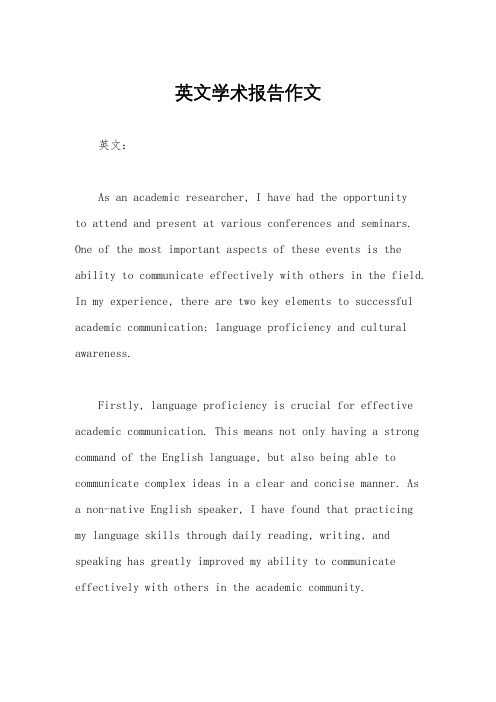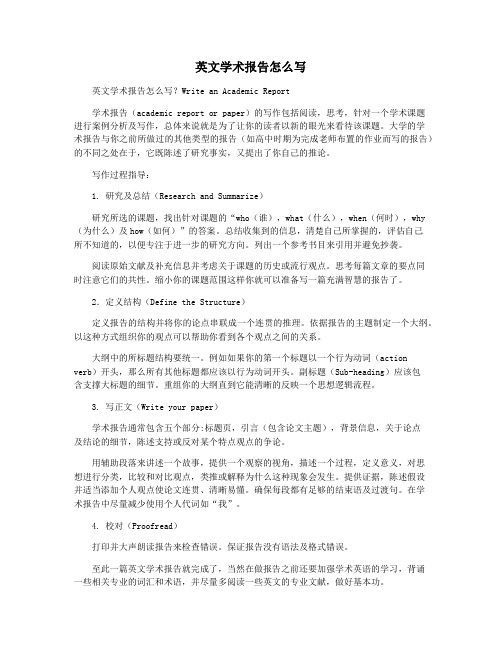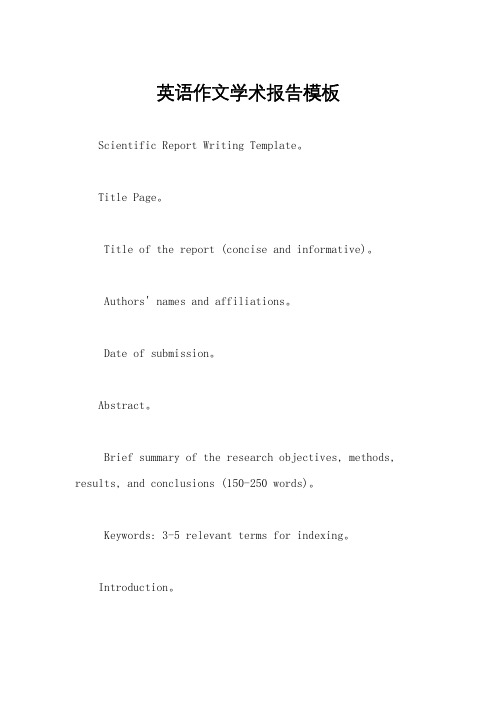英语学术报告
英语学术报告范文

英语学术报告范文Title: The Impact of Social Media on Mental HealthIntroduction:Good morning, ladies and gentlemen. Today, I will be presenting a report on the impact of social media on mental health. With the rapid advancements in technology over the past decade, social media platforms have become an integral part of our lives. However, it is important to understand the potential consequences that excessive social media use can have on our mental well-being.Outline:I. Overview of Social MediaA. Definition and purposeB. Popularity and growthC. Different platforms and their featuresII. Positive Effects of Social Media on Mental HealthA. Connection and communicationB. Access to informationC. Support and community buildingIII. Negative Effects of Social Media on Mental HealthA. Social comparison and self-esteemB. Cyberbullying and harassmentC. Addiction and time-wastingIV. Strategies to Promote Positive Mental Health on Social Media A. Limit screen timeB. Unfollow negative accountsC. Seek offline activities and relationshipsV. Future Directions and ConclusionBody:I. Overview of Social Media:Social media refers to online platforms that enable users to create, share, and exchange information and ideas. It has gained significant popularity, with billions of users worldwide. Various platforms exist, such as Facebook, Twitter, Instagram, and YouTube, each offering distinctive features for users to engage with others.II. Positive Effects of Social Media on Mental Health:While social media has drawn criticism for its potentially harmful effects, it also has several positives. Firstly, social media fosters connection and communication, allowing individuals to stay in touch with friends and family. It serves as a valuable tool for sharing experiences and building relationships. Additionally, social media provides access to a vast array of information, promoting learning and awareness. Lastly, it creates supportive communities for individuals who may feel isolated in their offline environment. III. Negative Effects of Social Media on Mental Health: Unfortunately, excessive social media use can adversely affect mental health. Social comparison, a common phenomenon on these platforms, can lead to feelings of inadequacy and low self-esteem. Moreover, cyberbullying and harassment are prevalent issues onsocial media, causing emotional distress and potentially leading to severe mental health conditions. Lastly, excessive usage can contribute to addiction and time-wasting, detrimentally affecting individuals' productivity and well-being.IV. Strategies to Promote Positive Mental Health on Social Media: To mitigate the negative effects of social media on mental health, individuals can adopt several strategies. Limiting screen time and setting boundaries for social media use is essential. Unfollowing accounts that promote negativity and comparison can also promote positive mental health. Lastly, engaging in offline activities and cultivating strong relationships outside of social media is crucial for overall well-being.V. Future Directions and Conclusion:The impact of social media on mental health is a continually evolving field of study. Future research should focus on understanding the nuances of social media usage and its effects on specific demographics. Additionally, online platforms must take responsibility for providing safer online environments to protect users' mental well-being. In conclusion, while social media offers numerous benefits, awareness and responsible usage are essential to mitigate its potential negative impact on mental health.Thank you for your attention.。
英文学术报告作文

英文学术报告作文英文:As an academic researcher, I have had the opportunityto attend and present at various conferences and seminars. One of the most important aspects of these events is the ability to communicate effectively with others in the field. In my experience, there are two key elements to successful academic communication: language proficiency and cultural awareness.Firstly, language proficiency is crucial for effective academic communication. This means not only having a strong command of the English language, but also being able to communicate complex ideas in a clear and concise manner. As a non-native English speaker, I have found that practicing my language skills through daily reading, writing, and speaking has greatly improved my ability to communicate effectively with others in the academic community.Secondly, cultural awareness is also important in academic communication. Understanding the cultural normsand expectations of others in the field can help to avoid misunderstandings and promote positive interactions. For example, in some cultures, it may be considered rude to interrupt someone during a presentation, while in others it may be seen as a sign of engagement. Being aware of these cultural differences can help to ensure that communicationis respectful and effective.In summary, language proficiency and cultural awareness are two key elements to successful academic communication. By continually improving our language skills and beingaware of cultural differences, we can promote positive interactions and advance our research in the field.中文:作为一名学术研究人员,我有机会参加和发表各种会议和研讨会。
英语口语学术报告范文

英语口语学术报告范文尊敬的各位老师和同学们:大家上午好!今天我将为大家做一个关于英语口语学术报告的范文分享。
首先我会简单介绍报告的主题,然后展示相关的数据和观点,并最后做出结论。
希望我的分享能给大家在英语口语学习和学术报告方面提供一些参考和借鉴。
我的研究主题是“使用游戏化教学方法促进英语口语水平的提升”。
我选择这个主题是因为近年来,随着数字媒体和游戏的普及,越来越多的教育者开始探索将游戏化教学应用于英语教学领域。
我想通过本次研究,探讨这种方法对于提高英语口语水平的效果。
在我的研究中,我选取了一所高中的两个班级作为实验组和对照组。
实验组的学生通过参与英语口语游戏来提升口语能力,而对照组则继续按照传统教学方法进行学习。
我在研究过程中采用了问卷调查、口语测试等方法来收集数据。
根据我的研究结果显示,通过游戏化教学方法提升英语口语水平的效果是显著的。
首先,通过游戏化教学,学生的学习兴趣明显增加。
传统的教学方法可能会让学生感到枯燥乏味,而游戏化教学可以激发学生的兴趣和参与度,使他们更积极主动地学习。
其次,游戏化教学方法可以为学生提供更多的练习机会。
很多学生在平时的英语学习中缺乏实践口语的机会,但通过参与游戏化教学,他们能够在轻松愉快的氛围中不断练习口语表达,进而提升口语水平。
此外,游戏化教学方法还能够培养学生的合作意识和团队精神。
在游戏过程中,学生需要进行合作,与他人交流和协作完成任务。
这种合作性质的学习可以帮助学生更好地理解团队合作的重要性,并培养他们的沟通能力。
最后,通过我的研究,我得出了结论:游戏化教学方法能够显著提高学生的英语口语水平。
然而,我也意识到这种教学方法并不适用于所有学生。
有些学生可能对游戏不感兴趣,或者游戏化教学方法可能无法满足所有学生的需求。
因此,在实际教学中,教师们需要根据学生的兴趣和特点进行灵活运用,以获得更好的教学效果。
总体而言,我的研究表明游戏化教学方法在提高英语口语水平方面具有一定的优势。
英文学术报告怎么写

英文学术报告怎么写英文学术报告怎么写?Write an Academic Report学术报告(academic report or paper)的写作包括阅读,思考,针对一个学术课题进行案例分析及写作,总体来说就是为了让你的读者以新的眼光来看待该课题。
大学的学术报告与你之前所做过的其他类型的报告(如高中时期为完成老师布置的作业而写的报告)的不同之处在于,它既陈述了研究事实,又提出了你自己的推论。
写作过程指导:1. 研究及总结(Research and Summarize)研究所选的课题,找出针对课题的“who(谁),what(什么),when(何时),why (为什么)及how(如何)”的答案。
总结收集到的信息,清楚自己所掌握的,评估自己所不知道的,以便专注于进一步的研究方向。
列出一个参考书目来引用并避免抄袭。
阅读原始文献及补充信息并考虑关于课题的历史或流行观点。
思考每篇文章的要点同时注意它们的共性。
缩小你的课题范围这样你就可以准备写一篇充满智慧的报告了。
2.定义结构(Define the Structure)定义报告的结构并将你的论点串联成一个连贯的推理。
依据报告的主题制定一个大纲。
以这种方式组织你的观点可以帮助你看到各个观点之间的关系。
大纲中的所标题结构要统一。
例如如果你的第一个标题以一个行为动词(action verb)开头,那么所有其他标题都应该以行为动词开头。
副标题(Sub-heading)应该包含支撑大标题的细节。
重组你的大纲直到它能清晰的反映一个思想逻辑流程。
3. 写正文(Write your paper)学术报告通常包含五个部分:标题页,引言(包含论文主题),背景信息,关于论点及结论的细节,陈述支持或反对某个特点观点的争论。
用辅助段落来讲述一个故事,提供一个观察的视角,描述一个过程,定义意义,对思想进行分类,比较和对比观点,类推或解释为什么这种现象会发生。
提供证据,陈述假设并适当添加个人观点使论文连贯、清晰易懂。
英语作文学术报告模板

英语作文学术报告模板Scientific Report Writing Template。
Title Page。
Title of the report (concise and informative)。
Authors' names and affiliations。
Date of submission。
Abstract。
Brief summary of the research objectives, methods, results, and conclusions (150-250 words)。
Keywords: 3-5 relevant terms for indexing。
Introduction。
Background information on the topic。
Statement of the research problem。
Hypotheses or specific aims。
Literature review: Summarize previous researchrelevant to the study。
Methods。
Detailed description of the research design, including: Participants or subjects。
Variables measured。
Data collection procedures。
Statistical methods。
Results。
Presentation of the data collected。
Statistical analyses and interpretation of findings。
Clear and concise tables, figures, or graphs。
Discussion of the significance of the results。
学术报告英语范文

学术报告英语范文Academic Report: Effective Strategies for Delivering Impactful PresentationsEffective communication is a crucial skill in the academic and professional realms. The ability to present complex ideas, research findings, and proposals in a clear and engaging manner can significantly impact one's success. This academic report examines the key strategies for delivering impactful academic presentations that captivate the audience and effectively convey the intended message.Establishing a Strong FoundationThe foundation of a successful academic presentation begins with thorough preparation. Researchers and presenters must delve deeply into the subject matter, gaining a comprehensive understanding of the topic. This comprehensive knowledge not only enhances the presenter's confidence but also allows them to anticipate and address potential questions or counterarguments.Crafting a Compelling NarrativeAn effective academic presentation is more than a mere recitation of facts and figures. It should tell a compelling story that engages the audience and guides them through the key points. Presenters must carefully structure their presentation, using a logical flow and cohesive narrative to lead the audience from the introduction to the conclusion. This narrative should be tailored to the specific audience, addressing their needs, interests, and expectations.Effective Visual AidsVisual aids can greatly enhance the impact of an academic presentation. Well-designed slides or other visual materials can help illustrate complex concepts, highlight key data, and reinforce the presenter's message. However, it is crucial to strike a balance, ensuring that the visual aids complement the presentation rather than overshadowing the presenter. Presenters must avoid the temptation to overload slides with excessive text or flashy animations, which can distract the audience and detract from the overall message.Engaging DeliveryThe delivery of the presentation is equally important as the content itself. Presenters must develop a confident and engaging speaking style, maintaining eye contact with the audience, using appropriate gestures, and modulating their tone and pace to sustain the audience's attention. Effective presenters also demonstrateenthusiasm and passion for their subject matter, which can inspire and captivate the audience.Anticipating and Responding to QuestionsAcademic presentations often conclude with a question-and-answer session, where the presenter must be prepared to respond to inquiries from the audience. Presenters should anticipate potential questions based on the content of their presentation and have well-formulated responses ready. Additionally, they must be able to think on their feet, providing clear and concise answers to unexpected questions while maintaining composure and professionalism.Incorporating Feedback and Continuous ImprovementDelivering impactful academic presentations is an ongoing process of learning and improvement. Presenters should actively seek feedback from their peers, mentors, and audience members to identify areas for growth and development. This feedback can be used to refine presentation skills, enhance the content and structure of the presentation, and better address the needs and expectations of the target audience.ConclusionEffective academic presentations require a multifaceted approach that combines thorough preparation, compelling storytelling, strategic use of visual aids, engaging delivery, and the ability torespond to audience questions. By mastering these key strategies, researchers and presenters can effectively communicate their ideas, share their findings, and make a lasting impact on their academic and professional communities. Continuous learning, self-reflection, and a commitment to improvement are essential for delivering impactful academic presentations that captivate and inspire the audience.。
英语学术报告开头稿子

英语学术报告开头稿子Ladies and gentlemen,Good morning/afternoon! It is my great pleasure to stand here and deliver this academic report. Today, I would like to talk about [insert topic/title of the report].In recent years, [insert topic/title of the report] has become an increasingly prominent issue in [insert relevant field or industry]. Its significance lies in the fact that [briefly explain the importance or relevance of the topic].The objective of this report is to provide a comprehensive overview of [insert topic/title of the report]. To achieve this, I will first delve into the background and context of the topic, followed by an exploration of the current state of research and development in this field. Moreover, I will present my own findings and analysis gained from [insert methodology or approach used for the research]. Lastly, I will conclude with a discussion of the potential practical implications and future directions for advancements in [insert topic/title of the report].Before I begin, let me share a personal motivation for choosing this topic. Through my academic journey and professional experiences, I have witnessed the growing significance of [insert topic/title of the report]. Recognizing its potential impact and the untapped opportunities it presents, I felt inspired to delve deeper into this area. Thus, I hope that this report will not only contribute to the existing knowledge in the field but also provide valuable insights for further research and development.To structure this report, I have divided it into [insert number] main sections. In each section, I will analyze the relevant aspects of [insert topic/title of the report] in a logical manner, ensuring that crucial elements are covered and well-explained.Lastly, before I conclude, I would like to express my gratitude to [insert names of individuals or organizations] for their support and assistance throughout the research process. Without their guidance and encouragement, this report would not have been possible.In conclusion, as we embark on this journey of understanding [insert topic/title of the report], I invite you all to join me in exploring the various aspects of this field, fostering a fruitful discussion, and collectively contributing to the advancement of knowledge in [insert relevant field or industry].Thank you for your attention, and I look forward to an engaging and insightful exchange of ideas during the subsequent sessions.。
英语学术报告 范文

英语学术报告范文English:When preparing an academic presentation in English, it is importantto first determine the topic and research question. This will guide the structure of the presentation and ensure that all necessary information is included. The introduction should provide background information on the topic and clearly state the research question. The body of the presentation should present the main points and findings of the research, using clear and concise language. Visualaids such as slides or graphs can help illustrate key points and keep the audience engaged. It is important to use academic language and cite sources properly throughout the presentation. Finally, the conclusion should summarize the main findings and implications of the research, leaving the audience with a clear understanding of the topic. Practice and rehearsal are essential to delivering a successful academic presentation in English.中文翻译:在准备英语学术报告时,首先确定主题和研究问题非常重要。
- 1、下载文档前请自行甄别文档内容的完整性,平台不提供额外的编辑、内容补充、找答案等附加服务。
- 2、"仅部分预览"的文档,不可在线预览部分如存在完整性等问题,可反馈申请退款(可完整预览的文档不适用该条件!)。
- 3、如文档侵犯您的权益,请联系客服反馈,我们会尽快为您处理(人工客服工作时间:9:00-18:30)。
英语学术报告:学术报告英语计算机视觉知乎英语记叙文事件范文英语议论文范文篇一:英文学术报告开场白、结束语問侯語或開場白的寒喧(Greetings)開場白很重要,最常用的問候是“Ladies and gentlemen”,但要視場合而定。
例如在會議討論會場合時,經由主席介紹上台時可先說Mr.Chairman,Honorable guest,Ladies and gentlemen,goodmorning ,It's very great pleasure indeed for me to be able to attend this meeting主席先生,各位貴賓,各位女士,先生早安(非常榮幸能參加這次的會議。
或者你也可以說I'mhornored and proud to have the opportunity to speak at this meeting .禮貌性的問侯語這是對主持人和來賓的一種尊重。
開始簡報(opening a presentation)—提出簡報摘要在正式進入主題之前可先扼要說明簡報的內容與順序,幫助聽眾了解您的報告的大概內容。
例,(Today I would like to present my paper“The challenges ofpharmacy practice in Taiwan”,In the first part of thereport ,I'm going to begin with a few general commentsconcerning the Taiwan Medical care enviroment recently, and then discuss in more detail specific issue which concerned community pharmacy,and how the National Health cave Insurance influence the future of pharmacist career?例,(你亦可將要簡報的摘要條列式的依序說明。
My presentation will cover the following aspects: professional pharmacy practice as part of the health -care systemSafe distribution of medicine co-operation for better drug therapy promotion of good healthRemuneration for pharmaceutical servicss進入主題(Main points)—演講部份的主要內容,論證與比較事實。
對所要簡報主題內容逐一詳細說明。
例如將上例每一項摘要逐項詳細闡釋說明,依序讓文章或演說有系統的講解。
在presentation 時如果能井然有序的,依段落分明,串聯成一篇完整文章,聽眾必定能印象深刻。
做結論(conclusion),演講後所做的總結,表明態度,正式結束一場簡報。
總結時通常要簡短的重述這場簡報的要點以加深聽眾對簡報內容的印象。
例,(Finally, I would like to make a conclusion with this presentation…最後我要為今天的簡報做結論… 例,(Inconclusion,I would like t o indicate the following…例,(To sammarize my main points,…例,(To conclude,…結尾語(closing remarks )—即收場白結束簡報時的客套語。
演講最後的致謝詞,感謝聽眾的聆聽。
Okay, Ladies and gentlemen,it has been my pleasure to give you my viewpoints on“The challenges of pharmacy practice in Taiwan. Thank you very much foryour kind attention.好的,各位女士、先生很榮幸能跟各位報告我對“台灣藥局執業的挑戰”觀點,非常感謝各位的聆聽。
問與答(,,,),最後留給聽眾發問的雙向溝通。
例:If you have any guestion s ,I would be happy to answer it .Thank you very much.例,(In conclusion,I would like to indicate the following…例,(To sammarize my main points,…例,(To conclude,…---------summarize篇二:英文学术报告怎么写英文学术报告怎么写,学术报告尤其是英文学术报告的写作对于中国学生来说是一个薄弱环节,反之,国外的教育对此则相当重视。
去国外学习,各种课程都可能要求你写报告,特别是商业、科学或技术类学科。
依据内容及导师要求的不同,报告的形式可能有所差别,但是写作的过程却是相似的。
美联英语学习网向您介绍英文学术报告怎么写,学术报告(academic report or paper)的写作包括阅读,思考,针对一个学术课题进行案例分析及写作,总体来说就是为了让你的读者以新的眼光来看待该课题。
大学的学术报告与你之前所做过的其他类型的报告(如高中时期为完成老师布置的作业而写的报告)的不同之处在于,它既陈述了研究事实,又提出了你自己的推论。
写作过程指导:1. 研究及总结(Research and Summarize)研究所选的课题,找出针对课题的“who(谁),what(什么),when(何时),why(为什么)及how(如何)”的答案。
总结收集到的信息,清楚自己所掌握的,评估自己所不知道的,以便专注于进一步的研究方向。
列出一个参考书目来引用并避免抄袭。
阅读原始文献及补充信息并考虑关于课题的历史或流行观点。
思考每篇文章的要点同时注意它们的共性。
缩小你的课题范围这样你就可以准备写一篇充满智慧的报告了。
2(定义结构(Define the Structure)定义报告的结构并将你的论点串联成一个连贯的推理。
依据报告的主题制定一个大纲。
以这种方式组织你的观点可以帮助你看到各个观点之间的关系。
大纲中的所标题结构要统一。
例如如果你的第一个标题以一个行为动词(action verb)开头,那么所有其他标题都应该以行为动词开头。
副标题(Sub-heading)应该包含支撑大标题的细节。
重组你的大纲直到它能清晰的反映一个思想逻辑流程。
3. 写正文(Write your paper)学术报告通常包含五个部分:标题页,引言(包含论文主题),背景信息,关于论点及结论的细节,陈述支持或反对某个特点观点的争论。
用辅助段落来讲述一个故事,提供一个观察的视角,描述一个过程,定义意义,对思想进行分类,比较和对比观点,类推或解释为什么这种现象会发生。
提供证据,陈述假设并适当添加个人观点使论文连贯、清晰易懂。
确保每段都有足够的结束语及过渡句。
在学术报告中尽量减少使用个人代词如“我”。
4. 校对(Proofread)打印并大声朗读报告来检查错误。
保证报告没有语法及格式错误。
至此一篇英文学术报告就完成了,当然在做报告之前还要加强学术英语的学习,背诵一些相关专业的词汇和术语,并尽量多阅读一些英文的专业文献,做好基本功。
篇三:英文学术报告无线通信学术研讨会摘要:随着通信网络的日益发展及3G与4G的应用与推广,第五代移动通信技术(5G),这一面向2020年之后产业发展的新一代移动通信技术系统,目前已经成为国内外移动通信领域的研究热点。
研讨会上,专家们分析了未来无线通信领域研究面临的机遇和挑战,并结合各自的研究方向,介绍了最新研究成果。
关键词 :HIVWi-Fi Massive MIMO 5G一、5G的发展前景及技术认知申滨教授和柴荣教授就5G的现今发展状况和一些研究此项目的途径做了一些讲解。
Krzysztof Wesolowski教授和大家一起探讨了5G的发展前景。
众所周知,1G主要解决语音通信的问题;2G可支持窄带的分组数据通信,最高理论速率为236kbps;3G在2G的基础上,发展了诸如图像、音乐、视频流的高带宽多媒体通信,并提高了语音通话安全性,解决了部分移动互联网相关网络及高速数据传输问题,最高理论速率为14.4Mbps;4G是专为移动互联网而设计的通信技术,从网速、容量、稳定性上相比之前的技术都有了跳跃性的提升,传输速度可达100Mbit/s,甚至更高。
5G弥补了4G技术的不足,在吞吐率、时延、连接数量、能耗等方面进一步提升系统性能。
它采取数字全IP技术,支持和分组交换,它既不是单一的技术演进,也不是几个全新的无线接入技术,而是整合了新型无线接入技术和现有无线接入技术(WLAN,4G、3G、2G等),通过集成多种技术来满足不同的需求,是一个真正意义上的融合网络。
并且,由于融合,5G可以延续使用4G、3G的基础设施资源,并实现与4G、3G、2G的共存。
5G将可提供超级容量的带宽,短距离传输速率是10Gbps,是目前LTE的100倍。
由于实现了多种网络技术的融合,因此5G也可以打破现有频谱资源的制约,实现全频谱通信;更重要的是,通过集成多种无线接入解决方案,5G技术将可以把人类社会彻底带入网络社会,实现万物互联。
5G的核心无疑是异构网的融合,它不同于之前的移动通信技术,需要考虑的是技术的融合与应用,其网络构架也有更复杂的要求,需要研究以下技术:支持高速移动互联的新型网络架构、高密度新型分布式协作与自组织组网、异构系统无线资源联合调配技术等。
二(无线通信的应用发展在这一块,周牧教授跟大家讨论了关于“个人移动建设基于众包的wi - fi室内映射”的课题。
首先众包指的是一个公司或机构把过去由员工执行的工作任务,以自由自愿的形式外包给非特定的(而且通常是大型的)大众网络的做法。
众包的任务通常是由个人来承担,但如果涉及到需要多人协作完成的任务,也有可能以依靠开源的个体生产的形式出现。
以3G技术与智能化终端的发展奠定的基础,经济社会进步为条件,受众的主动性需求为直接动力,众包作为实现手段,移动互联作为创新性媒介走入了我们的视线。
一、基于“众包”的移动互联传播创新现状移动互联是时代的产物,是移动设备与互联网双重优势结合的智能化产物,具有携带便捷,操作简单、私有属性,高隐私度等特点。
